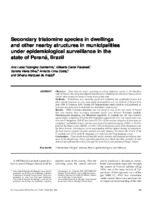Secondary triatomine species in dwellings and other nearby structures in municipalities under epidemiological surveillance in the state of Paraná, Brazil
| dc.contributor.author | Guilherme, Ana Lucía Falavigna | es_ES |
| dc.contributor.author | Pavanelli, Gilberto Cezar | es_ES |
| dc.contributor.author | Silva, Sandra Vieira | es_ES |
| dc.contributor.author | Costa, Arnaldo Lima | es_ES |
| dc.contributor.author | Araújo, Silvana Marques de | es_ES |
| dc.date.accessioned | 2015 | |
| dc.date.available | 2015 | |
| dc.date.issued | 2001 | es_ES |
| dc.identifier.citation | Guilherme, Ana Lucía Falavigna,Pavanelli, Gilberto Cezar,Silva, Sandra Vieira,Costa, Arnaldo Lima,Araújo, Silvana Marques de (2001) Secondary triatomine species in dwellings and other nearby structures in municipalities under epidemiological surveillance in the state of Paraná, Brazil. Rev Panam Salud Publica;9(6) 385-392,jun. 2001. Retrieved from http://www.scielosp.org/scielo.php?script=sci_arttext&pid=S1020-49892001000600005&lng=en&nrm=iso&tlng=en | en_US |
| dc.identifier.uri | http://www.scielosp.org/scielo.php?script=sci_arttext&pid=S1020-49892001000600005&lng=en&nrm=iso&tlng=en | es_ES |
| dc.identifier.uri | https://iris.paho.org/handle/10665.2/8586 | |
| dc.relation.ispartofseries | Rev Panam Salud Publica;9(6),jun. 2001 | es_ES |
| dc.subject | Triatominae | es_ES |
| dc.subject | Doença de Chagas | pt_BR |
| dc.subject | Brasil | pt_BR |
| dc.subject | Vigilância Epidemiológica | es_ES |
| dc.subject | Trypanosoma cruzi | es_ES |
| dc.title | Secondary triatomine species in dwellings and other nearby structures in municipalities under epidemiological surveillance in the state of Paraná, Brazil | en_US |
| dc.type | Journal articles | en_US |
| dc.rights.holder | Pan American Health Organization | en_US |
| dc.description.notes | OBJECTIVE: Since data are scarce regarding secondary triatomine species in the Brazilian state of Paraná, this study investigated infestations in inhabited and abandoned houses nad in various other nearby structures in rural areas of that state. METHODS: Triatomines were manually captured in inhabited and uninhabited ouses and other nearby structures in nine areas (eight municipalities and one district) of Paraná from June 1996 to February 2000. Testing for Trypanosoma cruzi infections was performed, as were also precipitin tests to detemine the triatomines' food sources. RESULTS: While Triatoma infestans was not found in any of the nine areas of Paraná that were studies, three secondary triatomine species were detected: Triatoma sordida, Panstrongylus megistus, and Rhodinus neglectus. T. sordida was the most common species found, comprising 575 of the 658 triatomines captured (87.4). The second-most common was P. megistus, with 82 specimens (12.5). Of the various categories of structures investigated, uninhabited houses was the most frequently infested category (19/62, or 30.6), followed by chicken coops (24/350, or 6.9). The primary food source fo the triatomines was the blood of birds. Nevertheless, in the municipality with the highest density of triatomines, the food sources included domestic animals and even humans. We found that 13.4 of the T. sordida and 13.5 of the P. megistus were infected with Trypanosoma cruzi. CONCLUSIONS: These results demonstrate the need to maintain entomological surveillance measures in the studied areas. This is especially important since Brazil and other countries of Latin America have affirmed the need to interrupt the vector-borne transmission of Chagas' disease | en_US |
Files in this item
This item appears in the following Collection(s)
-
Pan American Journal of Public Health
Revista Panamericana de Salud Pública

